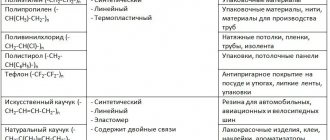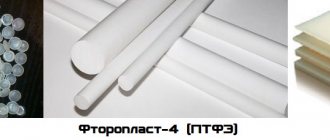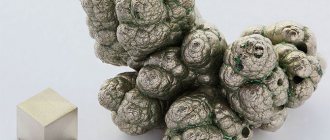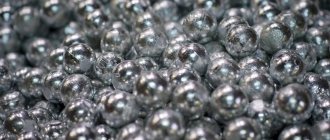A polymer (from the Greek words poly - many and meros - share, part) is a compound with a high molecular weight, the macromolecules of which consist of a very large number of simple, identical, repeating units (monomers) or repeating groups. For example, polyethylene [– CH2 – CH2 –]n is formed from the ethylene monomer CH2 = CH2, where the number n can reach several tens of thousands of units. It is characteristic of a polymer macromolecule that its length is a thousand times or more greater than its transverse size. Thus, for polystyrene with n = 6000, the macromolecule has a length of 1.5·10-6 m, and its transverse size is 1.5·10-9 m, i.e. 1000 times smaller. The simplest model of a macromolecule is a thread with beads attached to it, and this thread is in an entangled state.
The molecular weight of the polymer can range from 5000 to 1,000,000 amu. With such large sizes of macromolecules, the properties of substances are determined not only by the chemical composition of these molecules, but also by their mutual arrangement and structure.
By origin, polymers can be natural or synthetic. Natural polymers are proteins, polysaccharides, cellulose, starch, natural rubber, mica, asbestos, and natural graphite. Synthetic polymers include synthesized high-molecular substances obtained by polymerization or polycondensation (synthetic resins, fibers, rubbers, etc.). In this case, the leading group of polymers used are synthetic polymers.
Since macromolecules form chains consisting of individual links and extending in length over distances thousands of times greater than their transverse dimensions, macromolecules are characterized by flexibility (which is limited by the size of segments - rigid sections consisting of several links). The flexibility of macromolecules is one of the distinctive features of polymers.
If a macromolecule consists of units of different nature, then the material is called a copolymer. The introduction of units of a different nature into the polymer makes it possible to obtain a material with the required properties. For example, in addition to the main link, a styrene copolymer contains rubber, which increases the impact strength of the material.
Polymer macromolecules can have a linear, branched or network (cross-linked) structure (Fig. 1).
Rice. 1. Polymer structures : a - linear; b - branched; c - mesh (stitched)
Inside the macromolecule, between the atoms in all three cases there are strong covalent bonds, the energy of which is 300...500 kJ/mol. In polymers with linear and branched structures, the forces of attraction between negative and positive particles (Vander Waals forces) most often act between macromolecules, the energy of which is up to 10 kJ/mol, i.e. tens of times less. In polymers with a network structure, there are mainly strong covalent bonds between macromolecules.
Linear polymers have specific properties, in particular, the ability to form anisotropic highly oriented fibers and films, as well as large reversible deformations. As we move from linear polymers to branched and cross-linked polymers, the complex of their specific properties becomes less and less pronounced. Three-dimensional polymers with a very high network frequency do not possess these properties at all.
Based on the chemical structure of the main chain, homochain and heterochain polymers are distinguished. Macromolecules of homochain polymers in the main chain contain identical atoms (carbon, silicon, sulfur, phosphorus, etc.). A characteristic representative of this group are carbon-chain polymers, the main chain of which molecules consists of carbon atoms. In macromolecules of heterochain polymers, the main chain includes various atoms.
Polymers can only exist in two states of aggregation (solid and liquid). It is impossible to transform polymer macromolecules into a gaseous state without destroying the bonds of the main chain.
Polymer structure
Polymers are made up of many monomers. They can exist in the form of several structures.
- Linear - links are connected in series (cellulose).
- Branched - the links are arranged randomly (starch).
- Reticular - linear molecules connected to each other (rubber).
Macromolecules can consist of both identical and different units.
- Homopolymers are a chain of identical monomers.
- Copolymers are a chain of different units.
Polymers are made up of structural units that are repeating groups of atoms. The number of units in high molecular weight compounds is determined by the degree of polymerization. In the formula (-CH2-)n, the degree is indicated by the letter “n”.
Nature of Mixing
In the world of atoms and molecules, two main factors affect their mutual arrangement. The first of them is the force of intermolecular interaction. Thanks to this force, in solids the atoms are at equilibrium distances relative to each other.
Rice.
1. Dependence of the energy of interaction between atoms on the distance between them
Equilibrium distance r
0 (Fig. 1) corresponds to the minimum potential energy, and in order to displace atoms from this state, external forces need to do work.
As atoms come closer together, the energy can grow to infinity, and when they move away from each other, it quickly reaches zero, which corresponds to the destruction of a solid body. Obviously, this factor creates conditions for the ordered arrangement of molecules; it is called internal energy
U.
The second important factor is the well-known thermal motion of molecules. Thermal vibrations displace molecules from their equilibrium states, and, in contrast to the action of internal energy, “want” to mix all the atoms and create complete chaos. This is the so-called entropy contribution,
which is present in all thermodynamic processes;
it is denoted as ST
, where
S
is entropy, i.e., a function of disorder in the arrangement of atoms and molecules, and
T
is the absolute temperature. Naturally, this contribution increases with increasing temperature. The entropy factor is determined mainly by the ability of atoms to occupy as many different positions as possible in space. It is clear that the entropy of a gas is much higher than that of a solid, where the positions of the atoms are fixed.
In reality, the situation in the world of atoms and molecules is determined by the relationship of the above factors. Their difference U − TS
denoted by
F
and is called
free energy
.
A thermodynamic system, i.e. a system consisting of a huge number of individual atoms (molecules), always tends to the minimum free energy, which is determined by the competition of energy ( U
) and entropy (
TS
) contributions to its value.
Rice. 2.
Schematic representation of the structure of a mixture of polymers obtained by mechanical stirring
Returning to our topic formulated in the title of the article, it is important to emphasize the main feature of polymers - the chain structure of their macromolecules, which underlies all their characteristic properties. Since the atoms (atomic groups) in a polymer are interconnected by covalent (very strong) bonds, it is obvious that its entropy will be less than the entropy of the same number of small, independent molecules. In polymer chains, atoms (atomic groups) are not independent, since they are connected in chains, which prevents them from occupying any positions in space. It is this circumstance that explains the difficulties that arise when mixing two or more polymers. It is very difficult to homogeneously mix substances with low entropy values, since the entropic gain of free energy as a result of this process is very small. So macromolecules do not “want” to mix spontaneously, as, for example, alcohol and water molecules do. “Forcible” mixing of two polymers in an extruder does not lead to anything good: the result is a rough mixture of components, consisting of their extended aggregates of irregular shape, interspersed in a continuous matrix of the second polymer (Fig. 2). Such “coarsely ground” mixtures have low mechanical properties and, as a rule, irreproducible other properties. Obviously, obtaining polymer mixtures by simple mechanical mixing has no practical meaning.
At the same time, learning to obtain homogeneous, highly dispersed mixtures of polymers is extremely important and promising, since this opens up the possibility of producing an unlimited number of materials with new and often very valuable properties. So, since polymers, as a rule, do not “want” to mix spontaneously, chemists and technologists use all sorts of tricks to overcome this difficulty [].
Classification of polymers
In modern industry there are several dozen varieties of polymers that can be classified according to several criteria.
By origin
- Natural ones are found in natural conditions (cotton, linen).
- Synthetic polymers are produced using polymerization and polycondensation reactions (nylon).
- Artificial macromolecules are the result of modification of natural polymers (viscose is the result of transformation of cellulose).
By chemical composition
- Polyesters include the carboxyl group –COO (lavsan).
- Polyamide ones contain peptide bonds and the functional group –CO–NH2 (nylon).
- Organoelements include various elements from the periodic table D.I. Mendeleev (organosilicon polymers).
Interpolyelectrolyte complexes
So far we have tried to overcome the entropic difficulties that prevent the mixing of polymer molecules. To this end, whenever possible, we replaced the polymer with a monomer having a high level of entropy, and thanks to this “deception” we achieved our goal. We practically did not use the second regulating factor - internal energy.
In fact, chemists have been using internal energy to produce mixtures of polymers for a long time. To do this, it is necessary to make macromolecules of different nature “attractive” to each other, to force them to attract each other. And what could be more attractive (attractive) than the attraction (interaction) of opposite electric charges? For this purpose, special functional groups were introduced into the polymers: some were positively charged, and others were negatively charged (Fig. 11).
Rice. eleven.
Scheme of the formation of an interpolyelectrolyte complex from two polymers, the chains of which have positive and negative electrical charges
If solutions of these polymers are merged together, then the energy gain that will be brought by the interaction of opposite electric charges will more than cover the entropic loss from mixing polymer molecules. As a result, oppositely charged macromolecules will be intensely attracted to each other with the formation of interpolyelectrolyte complexes
[]. Such complexes are often insoluble in water and, when solutions of oppositely charged macromolecules merge, they precipitate. The latter is a very homogeneous mixture of two strongly interacting polymers, which is often very difficult to separate into its original components.
So far, we have considered methods for producing polymer-polymer mixtures, implemented using chemical reactions (synthesis of various types of copolymers, interpenetrating networks or interpolyelectrolyte complexes). But from a practical point of view, this is not always convenient, since low molecular weight organic molecules are often explosive, toxic and create environmental problems. The search for possible ways to mix polymers without the participation of chemical processes continues, and some success has been achieved.
Methods for producing polymers
Polymers can be obtained as a result of polymerization and polycondensation reactions.
Polymerization
Polymerization is an addition reaction. This is a chain reaction consisting of three stages - initiation, growth and chain termination.
n CH2=CH2 + n CH3-CH=CH2→ [(-CH2-CH2-)x-(-CH2-CH(CH3)-)y]n
Sodium, peroxides, and complex compounds act as reaction catalysts. As a result of polymerization, important compounds are formed.
Polycondensation
Polycondensation is a displacement reaction that releases low molecular weight by-products. Polycondensation is a stepwise reaction. Polymers are formed by the sequential interaction of monomers, dimers or n-mers.
n C6H12O6→ (-C6H12O5-)n + n H2O
As a result of polycondensation, the most important high-molecular compounds are formed.
Interpenetrating polymer networks
There is another general approach for creating multicomponent polymer systems. It takes advantage of one of the amazing properties unique to polymers - their ability to swell. If we want to dissolve a substance, such as sugar, in water and bring these substances into contact, the following will happen. Sucrose molecules located on the surface will successively break away from it and move into the environment. This process will continue until all the sucrose molecules are in an aqueous environment, resulting in the formation of a homogeneous solution of sugar in water.
Rice. 9.
Structure of polymer 1 swollen in monomer 2
In the case of polymers, the process is fundamentally different. When a polymer is brought into contact with a solvent, the smaller and therefore more mobile solvent molecules will rush into the polymer phase. In other words, when a polymer comes into contact with a solvent, individual macromolecules will not initially be split off from its surface, but the swelling process will begin. This becomes possible because polymer molecules with a chain structure are able to change their shape (conformation). The folded macromolecules in the original, solid polymer begin to unfold, freeing up spaces between each other for small solvent molecules (Fig. 9). This process occurs spontaneously, primarily because when small molecules penetrate into the volume of the polymer, the total entropy of the polymer-low-molecular substance system increases. As a result, the total volume of the polymer increases, sometimes very significantly - by hundreds and sometimes thousands of percent.
Rice. 10.
The structure of an interpenetrating polymer network in which chains of one polymer (
solid lines
) are mixed with chains of another polymer (
dashed lines
)
Knowing this feature of polymers, chemists quite a long time ago and very successfully tried to implement the following idea. They took liquid monomer No. 2 as a solvent and brought it into contact with the finished polymer No. 1. As a result, swelling occurred and a material was formed, the structure of which is shown in Fig. 9. After this, polymerization of monomer No. 2 was carried out directly in polymer No. 1 ( in situ
). This approach made it possible to obtain an almost unlimited number of polymer-polymer mixtures, which were called interpenetrating polymer networks []. In this case, a second one is formed inside one polymer network, although the original “ready” polymers cannot be mixed. The structure of such a double grid is shown in Fig. 10.
Physical properties of polymers
Polymers are characterized by two states: crystalline for stereoregular macromolecules and amorphous for high-molecular compounds with a random arrangement of units. All high molecular weight substances have the following properties.
- Low thermal conductivity (when a metal pan is heated, plastic handles do not melt).
- Flexibility (applying a polymer layer to metal plates).
- Rapid ignition (on an open fire, plastic quickly melts and releases toxins).
- Electrical insulating properties (socket plugs are made from high molecular weight compounds).
Based on their special thermal properties, high-molecular compounds are classified into two groups.
- Thermoplastics return to their original shape after exposure to high temperatures.
- Thermosetting materials are destroyed when heated.
All polymers are in liquid and solid aggregate states. They can be liquids (lubricants, varnishes, adhesives, paints), elastic materials (rubber, silicone, foam rubber) and hard plastics (polyethylene, polypropylene).
Chemical properties
The reactions of high molecular weight compounds are determined by the functional group. If the compound contains a hydroxyl group-OH, then the polymer undergoes the same reactions as alcohols. If the macromolecule contains a carboxyl group –COOH, then the polymer is characterized by the same reactions as carboxylic acids.
Reactivity increases in the presence of double bonds and functional groups. They also determine the ability of individual macromolecules to be cross-linked. Examples of cross-linking include vulcanization and the transfer of linear macromolecules of thermosetting polymers into network structures.
Impact resistant polystyrene
The previous section essentially demonstrated the case where a brittle glassy polymer (PS) is transformed into a plastic, highly elastic product when rubber-like PB blocks are attached to PS chains. However, it should be noted that the production of block copolymers is a very complex, labor-intensive and quite expensive process. At the same time, PS is one of the cheapest polymers, easily produced and produced in huge quantities (hundreds of thousands of tons). It has low moisture absorption, high moisture and frost resistance, excellent dielectric characteristics, is insoluble in water, easy to shape and paint, can be easily machined and glued. Unfortunately, as noted above (Fig. 6), such an attractive polymer has one very serious drawback. This is a fragile material. At room temperature, it collapses if it is stretched by only 1-3%. In Fig. 6, the tensile curve of pure PS is difficult to discern, it is so close (due to its fragility) to the ordinate axis.
It is not surprising, therefore, that chemists and technologists have long been trying (since the first half of the twentieth century) to somehow reduce the fragility of PS in order to expand the areas of its practical use. One such successful attempt was the polymerization of styrene (the monomer for making PS) with the addition of a small amount of soft rubbery polybutadiene. Since the PB macromolecule contains double bonds, in this case we essentially carry out graft copolymerization of styrene with PB. The molecular structure of the graft copolymer was discussed above (it is shown in Fig. 4, a
).
Despite the fact that the soft component (SB) in such a copolymer is, as a rule, small (no more than 5–10%), this amount is quite enough to decisively change the mechanical behavior of the material, and, first of all, relieve it from fragility. For this reason, the product obtained as a result of this reaction was called high-impact polystyrene
(HIPS) [].
Rice. 7.
Tensile curves of pure (
1
) and impact-resistant PS (
2
) at room temperature
In Fig. Figure 7 shows the tensile curves of PS (1) and UPS (2). It is clearly seen that pure PS, as noted above, is destroyed at small deformations (1–3%), while UPS can be deformed under tensile conditions by 40 percent or more, i.e., the unpleasant property of PS (brittleness) is completely is lost. Moreover, if the 30% stretched PS is released from the clamps of the stretching device, the polymer exhibits significant shrinkage, which is completely uncharacteristic of the glassy state of the polymer in which pure PS is located at room temperature. The question arises: how does a small amount (5–10%) of added PB change the mechanical behavior of the resulting product so dramatically?
Structural studies provide an answer. PS and PB, like most polymer pairs, are incompatible, and for this reason, during the copolymerization reaction of styrene and PB, a process of phase separation occurs. However, this division occurs in a very peculiar way. PB, released into a separate phase and having a dark color, forms small inclusions in a continuous polymer matrix (Fig. 8a
).
These inclusions contain significant amounts of PS and are uniformly distributed throughout its volume. If we deform a pure PS (Fig. 7, curve 1
), then the defect (stress concentrator) that inevitably arises, as in any deformable solid, will grow and lead to its macroscopic destruction.
The presence of many small inclusions in the UPS (Fig. 8, a
), uniformly distributed in the material, prevents the formation of one such dangerous defect.
Instead, the continuous PS matrix itself begins to inelastically (plastically) deform between the indicated inclusions. Zones of such deformed material in Fig. 8, b
are visible in the form of dark stripes connecting adjacent rubber inclusions.
Zones of this kind of plastically deformed polymer have a microporous structure and are called crazes (Fig. 8, c
). This phenomenon was discussed in more detail earlier [], but here we just note that the creation of such highly dispersed formations requires a significant amount of mechanical work, which is what we observe in the experiment. The work of deformation is characterized by the area under the tensile curve (Fig. 7); it is easy to verify that the indicated work in the case of deformation of the SPS is several orders of magnitude greater than in the case of deformation of pure PS.
Rice. 8.
Electron micrographs of ultrathin sections of impact-resistant PS before deformation (
a
) and after stretching by 30% at room temperature (
b
).
Electron micrograph of a single craze in a PS film ( c
)
Application of polymers
The first polymer materials appeared at the beginning of the twentieth century. Paints and films were produced by processing cellulose and oil refinery waste. Thanks to this discovery, cinema began to develop. Now children's toys, synthetic fabrics, rubberized shoe soles, sports equipment, computer equipment, etc. are made from plastic.
It is impossible to imagine civilization without polymers. Each of them is special and is used in many areas.
- Polyethylene – packaging, insulation of electrical wires, automotive parts, corrosion protection of oil pipelines.
- Polystyrene – toys, equipment parts, interior lining of car and airplane interiors, fittings, external electronics parts, dishes.
- Polyvinyl chloride – automobile parts, chemical industry equipment, artificial leather.
- Polycarbonate – parts for electronics and automobiles, materials for construction.
- Epoxy resin – decorative decorations, varnishes, glue, laminate.
- Polyester – lamps, masts, protective equipment, aircraft and machine bodies.
Space industry scientists have created flying rockets and satellites based on polypropylene. In laboratory tests, it turned out that the low mass of this raw material helps overcome the Earth’s gravity without much effort, and the plastic does not deform under large temperature changes in an aggressive environment.
The future of polymers
High molecular weight compounds are the future of humanity. But they can be not only useful, but also dangerous for people. At the moment, the world faces a problem with the disposal of plastic, which takes a long time to decompose and releases toxins. The inhabitants of the seas and oceans feed on garbage, which negatively affects nature.
Scientists are tackling the problem of discarded plastic by developing “smart high molecular weight compounds” that can change their structure and properties depending on the environment. Polymers are the object of research by scientists. The following developments are currently underway.
- Biodegradable films containing corn starch.
- Packaging that changes color depending on the shelf life of the product and decomposes without harm to nature.
- Eco-soil with hydrogel for dry areas of natural agriculture.
- Polymer liquids that change properties depending on the environment.
- Pharmaceutical packaging for delivering medicines directly to a diseased organ inside the human body.
Humanity can no longer develop without polymer products. Now the question is about its safety for the environment and the transition to a new level of interaction. It is impossible to give up plastic, but it is possible to reduce its consumption and switch to products made from natural materials.
Power Assembly
One of the ways to obtain multicomponent polymer systems is power assembly
multilayer structures.
This method of producing polymer mixtures is based on the amazing properties of polymer melts. It turns out that if you press two incompatible polymer melts through a flat slit (die), they separate into separate layers. Upon subsequent pressing of this exfoliated system through the next die, the number of such layers doubles, etc. As a result, multilayer polymer films are formed, which can be considered as a kind of polymer mixtures []. The device for such an assembly is shown schematically in Fig. 12. A community of N
consecutive dies gives the number of layers in the film 2(
N
+1).
Rice. 12.
Diagram of a device for coextrusion of melts, allowing for the power assembly of multilayer films based on incompatible polymer pairs. The figure shows the initial stage of the process of obtaining films containing from 2 to 8 layers
Rice. 13.
Atomic force microscopic image of a cross section of multilayer films based on PETG - PS, having a different number of layers of different thicknesses []
It would seem that the resulting product can hardly be called a mixture of polymers, because the layers in them remain single-component. However, the force coextrusion method makes it possible to reduce the thickness of the layers down to the nanometer level, and with such sizes of contacting films, qualitative changes occur in their structure. In Fig. Figure 13 shows microscopic images of thin sections of multilayer films based on two incompatible polymers (polyethylene terephthalate-co-1,4-cyclohexanedimethylene terphthalate-polystyrene copolymer) obtained by force coextrusion []. It can be clearly seen that while the thickness of the polymer layers is 30–60 nm, these are truly multilayer polymer films. However, a further decrease in the thickness of the layers leads to blurring of phase boundaries and practical mixing of incompatible polymers into a single composition. Naturally, this circumstance greatly affects the properties of the resulting materials.
So, it is possible to obtain a highly dispersed mixture of incompatible polymers without the use of chemical reactions, although this may require the manufacture of rather complex chemical-technological devices (Fig. 12).











